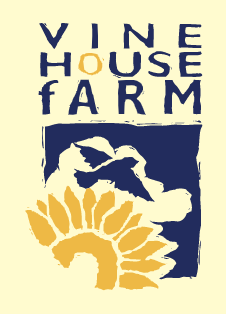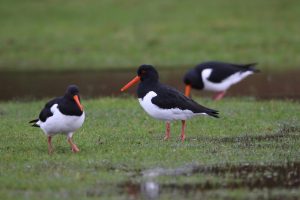
With 40mm of rain on the first three days of January we thought we were in for a very wet month but fortunately the taps were turned off and January was only a bit wetter than average with 53 mm. It was only a bit warmer than normal, with the average temperature 4.6°C.

After a wet December and 40mm on the first three days of January, our farms were full of water. The fourth day the Bourne Eau burst its bank into Bourne South Fen, and the day after the Welland burst into Cowbit Wash. It had been 75 years since any river had burst its bank in this area. The Environment Agency, the EA, are responsible for the maintenance on both rivers, but little major maintenance has been done, so they were breaches that would eventually happen.
In June 2023, the Welland and Deepings Internal Drainage board had warned the EA that the banks of the Bourne Eau were very weak, but nothing was done about it. Forty years ago, the Welland was 14ft deep, now it is only 8ft deep; the EA know this but no dredging has been carried out. Dredging is controversial. If, as a country, we are going to continue to build new houses, industries and new roads, we will continue to put more pressure on our rivers and this is before we talk about global warming. Something has to give.
Four weeks later neither breach has been repaired and is not likely to be for a few weeks, because the EA has no money. Asked why no maintenance has been done on these rivers, and their answer is there is no money for maintenance, and yet we are told that government has spent an extra £6 billion on flood protection.
Before the Welland was widened, from Fosdyke to Tallington, with relief channels around Spalding and the Deepings, the Cowbit and Crowland Washes would flow out by gravity at low tide. The Welland was tidal up to Market Deeping, but when the river was widened in 1952, tidal sluices were installed near West Marsh road. This keeps the water in the Welland through Spalding at about nine feet above sea level, meaning that now all the water in Crowland and Cowbit Washes has to be pumped out by the local drainage boards.
We are not on our own in South Lincolnshire, there are several other rivers flowing through the Fens and other low-lying areas north of us that have burst their banks, flooding farmland. All of which need repairing and all of which can be attributed to lack of maintenance or badgers. Fortunately, none of our farmland has been affected by any of these breaches.
We are also very fortunate that the rain stopped after January 3rd. All of our fields have been steadily drying out, so that we have been able to lift the rest of our sugar beet and get those fields drilled with wheat.
There is always something to say about potatoes and this month is no exception. With less potatoes being grown nationwide last year and not all of them lifted, prices have been rising. The free buy prices are the highest we have seen them in 20 years.


The wet weather has certainly benefitted some species of birds. None of us can remember seeing flocks of birds on Crowland and Cowbit washes, but within a few days of being flooded, there were large flocks of birds on the washes. The most Whooper Swans we have had in the area in previous winters has been about 500, but there are now about 1500 feeding on the washes or the surrounding farmland. The availability of food hasn’t changed, it is the roosting habitat that has increased. The safest place they can roost is on water; the water on the washes is only one or two feet deep and so they can be feeding all night if they wish. As well as the Whooper Swans, there are two or three thousand Lapwings feeding in the shallow waters and more than 500 ducks as well. All in all, a scene that we have never seen before and might never see again.
Although most of January was dry, it was windy and that will not have suited Barn Owls. The autumn was also tough for them as it was the wettest autumn we have had in the past 200 years. I have not yet inspected any of my nest boxes, but I do see fresh pellets underneath some of them, so I know we still have some Barn Owls.
We’ve had a large increase of Blackbirds in the Vine House Farm garden during the cold spell last month – my largest count was 19. To increase the number of Blackbirds in your garden, you must spread the food out, because if you only feed them in one place, they will spend more time fighting than feeding. The cold weather showed me quite how much extra birds must eat when it is cold. When the cold weather disappeared, the Blackbirds also disappeared, as they are territorial, I was seeing seven or eight at any one time. The Tit family were also swarming around the fat blocks during the cold weather, but not so when the cold weather disappeared.
The Moorhens on our pond have again been disappointing. A few years ago, something was taking their eggs, so we built them a small house, put it on a pallet and floated it on the pond. The results that year were excellent, they had four broods and reared 12 young. Ever since then however, their productivity has decreased and this year they have only reared one chick. The pair have also become very dominant, five years ago 10 or 12 of them on the pond were a happy family, but now the breeding pair are soon falling out with their offspring.
Tree Sparrows have done well again this year; they have reared about 3.5 young per brood and have had about 2.7 broods per nestbox, but they have decreased in numbers! I first noticed Tree Sparrows nesting near some ponds in 2005, in the base of a Carrion Crow’s nest, as they had nowhere better to nest. I put a couple of nest boxes up for them and they took to them. I also fed them, and their numbers increased, so much so that in 2017 I ringed 1,000 young Tree Sparrows on the farm. Ever since then they have declined in numbers, even though their productivity has been constant.
This is the usual trait that Tree Sparrows show: a build-up, then a decline. It seems that naturally Tree Sparrows do move on after several years, it could be that a large colony of birds attract a predator, or they catch a disease, or they fill all the holes up with nesting materials.



